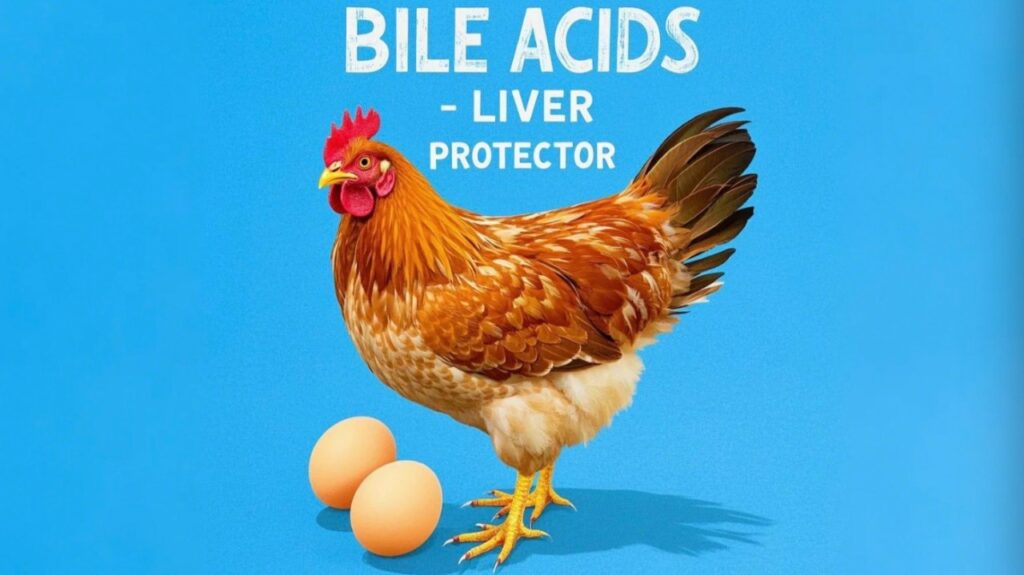Before we learn about how bile acids help laying hens in fatty liver problem, Let learn about the what is the fatty liver in laying hens and the reasons:
1. Definition of Fatty Liver in Laying Hens
Fatty liver in laying hens, also known as fatty liver hemorrhage syndrome, is a nutritional and metabolic disease characterized by liver hemorrhage and hepatic steatosis.
2. Causes of Fatty Liver in Laying Hens
The root cause is excessive energy intake from feed, leading to accumulation of fat in the liver due to insufficient transportation. Caged laying hens fed high-energy diets are particularly prone to this condition.
3. Hazards of Fatty Liver in Laying Hens
Fatty liver reduces production performance in mid-to-late laying periods and is a major cause of mortality. It affects well-conditioned caged hens during peak lay globally. The incidence rate is approximately 30%, accounting for 10% of total deaths, and can reduce egg production by up to 50% in severe cases.
4. Symptoms of Fatty Liver in Laying Hens
Affected hens are often obese, nervous, anorexic, and experience significant egg production decline or cessation. Stressful events like catching, relocating, or transportation may trigger sudden death. Post-mortem examination reveals abdominal hemorrhage, clotted blood around the liver, and a swollen liver (2-3 times normal size) with a yellowish-brown, fragile texture.
Before Treatment
Liver appears yellowish-brown, soft, fragile, with extensive bleeding spots or clots.
After Treatment
Liver is smooth, glossy, firm, normal dark red, without bleeding spots.
5. Mechanism of Bile Acid in Alleviating Fatty Liver
Bile acids regulate glucose, lipid, and energy homeostasis through activation of nuclear receptors (FXR, VDR, PXR) and membrane receptors (TGR5, S1PR2). Key pathways include:
FXR-Mediated Lipid Metabolism
- Inhibits Lipogenesis: Upregulates SHP to suppress SREBP-1c, FASN, and SCD1.
- Promotes Fatty Acid Oxidation: Activates PPAR-α to upregulate CPT1.
- Enhances TG Metabolism: Activates lipoprotein lipase to hydrolyze triglycerides.
- Improves Lipid Export: Upregulates MTP and VLDLR to facilitate TG clearance.
TGR5-Mediated Glucose Metabolism
- Enhances Lipolysis: Increases FFA availability for β-oxidation and thermogenesis.
- Improves Insulin Sensitivity: Induces GLP-1 secretion, reduces FFA levels, and alleviates insulin resistance.

6. Application of Bile Acid in Poultry
Dosage based on 30% bile acid content:
1. Poultry Compound Feed
- Dosage: 100-200 g/metric ton
- Benefits:Promotes growth and uniformity in chicks.Improves feed intake, weight gain, and feed conversion efficiency.Enhances digestion of fats and fat-soluble vitamins.Supports liver, gallbladder, and intestinal health.
2. On-Farm Supplementation
A. Laying/breeding poultry
- Dosage: 250-300 g/metric ton, administered 10 days/month
- Benefits:Prevents fatty liver and gallbladder problesm – related mortality.Resolves fatty diarrhea from excessive dietary fat.Improves eggshell quality unresponsive to calcium-phosphorus adjustments.Reduces mortality and extends peak lay.
B. Broilers
- Dosage: 300 g/metric ton, administered for 5-7 days
- Benefits:Alleviates hepatic injury from high-fat diets.Mitigates mycotoxicosis symptoms (gizzard erosion, diarrhea, pale combs).Reduces abdominal fat percentage.
WE ARE THE MANUFACTURER OF BILE ACIDS.

